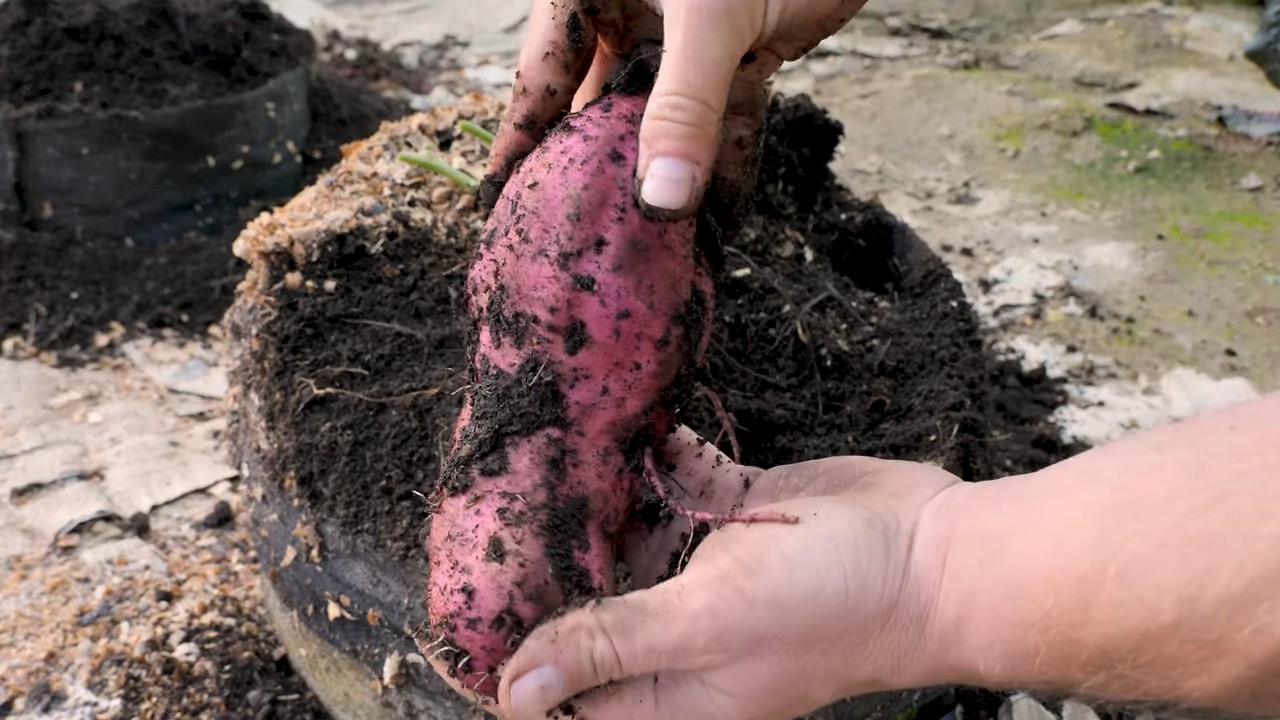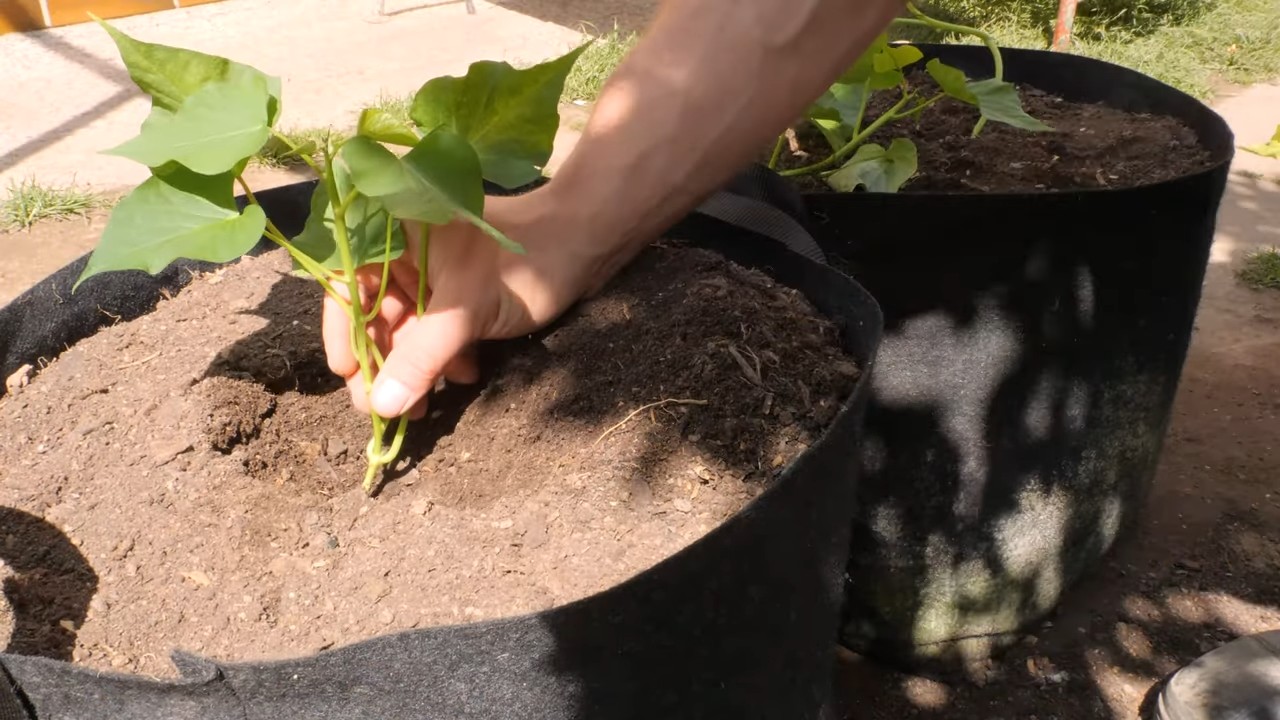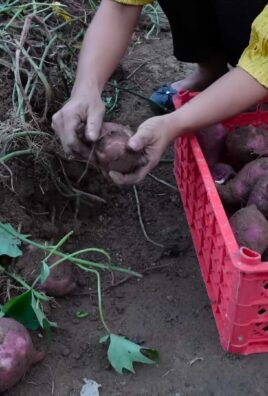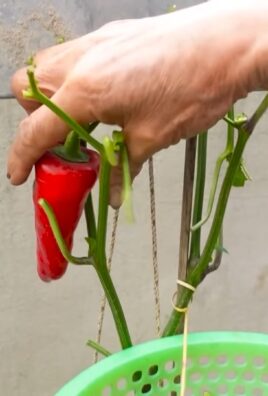Growing Sweet Potatoes in Pots: Imagine harvesting a bounty of sweet, earthy goodness right from your own patio! For centuries, sweet potatoes have been a staple crop, enjoyed across cultures for their delicious flavor and nutritional benefits. From the indigenous peoples of the Americas, who first cultivated these vibrant tubers, to their widespread adoption in cuisines worldwide, sweet potatoes have a rich and fascinating history.
But what if you don’t have acres of farmland? That’s where the magic of container gardening comes in! Many people believe that growing sweet potatoes requires a large garden, but I’m here to tell you that’s simply not true. With a few simple tricks and a little DIY know-how, you can successfully grow sweet potatoes in pots, even if you’re short on space.
This DIY guide is your ticket to fresh, homegrown sweet potatoes, no matter where you live. We’ll walk you through every step, from choosing the right pot and soil to nurturing your plants for a plentiful harvest. Why spend money on store-bought sweet potatoes when you can enjoy the satisfaction of growing your own, knowing exactly where they came from and how they were cared for? Let’s get started and unlock the secrets to growing sweet potatoes in pots successfully!

Growing Sweet Potatoes in Pots: A Beginner’s Guide
Hey there, fellow gardening enthusiasts! Ever thought about growing your own sweet potatoes? It’s easier than you might think, and you don’t even need a sprawling garden. You can absolutely grow these delicious tubers in pots! I’m going to walk you through the whole process, from choosing the right pot to harvesting your sweet potato bounty. Let’s get our hands dirty!
Choosing the Right Pot and Soil
Before we even think about planting, we need to get our setup right. This is crucial for success, so let’s dive in:
* Pot Size Matters: Sweet potatoes need room to grow. I recommend a pot that’s at least 15-20 gallons in size. The bigger, the better, honestly! Think about a half-barrel planter or a large, sturdy plastic container. Depth is more important than width, as the sweet potatoes grow downwards.
* Drainage is Key: Make sure your pot has plenty of drainage holes. Sweet potatoes don’t like soggy feet! If your pot doesn’t have enough holes, drill a few more.
* Soil Selection: Forget heavy clay soil! Sweet potatoes thrive in loose, well-draining soil. I like to use a mix of:
* Compost (for nutrients)
* Potting mix (for drainage and aeration)
* A little bit of sand (to further improve drainage)
* Sunlight is Essential: Sweet potatoes are sun-worshippers! Choose a spot that gets at least 6-8 hours of direct sunlight per day.
Sprouting Your Sweet Potato Slips
Okay, now for the fun part – growing the slips! Sweet potato slips are the sprouts that grow from the sweet potato itself, and these are what we’ll plant in our pots. You can buy slips online or at your local garden center, but it’s super satisfying (and cheaper!) to grow your own. Here’s how I do it:
1. Choose a Healthy Sweet Potato: Select an organic sweet potato from the grocery store or farmer’s market. Organic is important because non-organic potatoes may be treated to prevent sprouting. Look for one that’s firm and free of blemishes.
2. The Water Method: This is my favorite method.
* Grab a glass jar or container.
* Insert toothpicks around the middle of the sweet potato. These will act as supports.
* Suspend the sweet potato in the jar, with the bottom half submerged in water.
* Place the jar in a warm, sunny location.
* Change the water every few days to keep it fresh.
3. The Soil Method: Alternatively, you can bury the sweet potato halfway in a container filled with moist potting mix. Keep the soil consistently moist and place the container in a warm, sunny spot.
4. Patience is a Virtue: It can take several weeks for slips to sprout, so don’t get discouraged if you don’t see anything happening right away. Just keep the water fresh (or the soil moist) and be patient.
5. Harvesting the Slips: Once the slips are about 6-8 inches long, they’re ready to be harvested. Gently twist or cut them off the sweet potato.
6. Rooting the Slips: Before planting, it’s a good idea to root the slips in water. Place the cut ends of the slips in a glass of water, making sure the leaves are above the water line. Roots should start to form within a few days.
Planting Your Sweet Potato Slips
Alright, we’ve got our pots, our soil, and our rooted slips. Time to plant!
1. Prepare the Pot: Fill your pot with the soil mixture we talked about earlier, leaving a few inches of space at the top.
2. Planting the Slips: Gently dig a small hole in the soil for each slip. Plant the slips about 4-6 inches apart, burying the roots and the bottom part of the stem. Leave the leaves above the soil.
3. Water Thoroughly: After planting, water the slips thoroughly. This will help them settle in and establish their roots.
4. Mulch (Optional): I like to add a layer of mulch around the base of the plants. This helps to retain moisture, suppress weeds, and regulate soil temperature. Straw or shredded leaves work well.
Caring for Your Sweet Potato Plants
Now that your sweet potato plants are in their new home, it’s time to provide them with the care they need to thrive.
1. Watering: Sweet potatoes need consistent moisture, especially during hot weather. Water deeply whenever the top inch of soil feels dry to the touch. Avoid overwatering, as this can lead to root rot.
2. Fertilizing: Sweet potatoes are heavy feeders, so they benefit from regular fertilization. I like to use a balanced organic fertilizer every few weeks. You can also use compost tea or fish emulsion.
3. Sunlight: Remember, sweet potatoes need at least 6-8 hours of direct sunlight per day. If your plants aren’t getting enough sun, they may become leggy and produce fewer sweet potatoes.
4. Weeding: Keep the area around your sweet potato plants free of weeds. Weeds compete with the plants for nutrients and water.
5. Vine Management: Sweet potato vines can get quite long and unruly. You can let them trail along the ground, or you can train them to climb a trellis or support. Pruning the vines can also help to encourage tuber development. I usually let them do their thing, but if they start taking over, I’ll give them a little trim.
6. Pest Control: Sweet potatoes are generally pest-resistant, but they can be susceptible to certain pests, such as aphids and sweet potato weevils. Inspect your plants regularly for signs of pests. If you find any, you can try spraying them with insecticidal soap or neem oil.
Harvesting Your Sweet Potatoes
The moment we’ve all been waiting for! Harvesting your sweet potatoes is the most rewarding part of the process.
1. Timing is Everything: Sweet potatoes typically take about 90-120 days to mature. You’ll know they’re ready to harvest when the leaves start to turn yellow and die back. This usually happens in the fall, before the first frost.
2. Gentle Digging: Carefully dig around the base of the plant, being careful not to damage the sweet potatoes. Use a garden fork or trowel to loosen the soil.
3. Lifting the Tubers: Gently lift the sweet potatoes out of the soil. Brush off any excess dirt.
4. Curing: Curing is an important step that helps to improve the flavor and storage life of your sweet potatoes. To cure them, place them in a warm, humid place (around 80-85°F and 85-90% humidity) for about a week. A greenhouse or a warm, sunny room works well.
5. Storing: After curing, store your sweet potatoes in a cool, dry, and dark place (around 55-60°F). They should keep for several months.
Troubleshooting
Even with the best planning, things can sometimes go wrong. Here are a few common problems you might encounter and how to deal with them:
* Yellowing Leaves: This could be a sign of overwatering, underwatering, nutrient deficiency, or pest infestation. Check the soil moisture, fertilize if necessary, and inspect for pests.
* Leggy Growth: This usually indicates insufficient sunlight. Move your plants to a sunnier location.
* No Sweet Potatoes: This could be due to a variety of factors, including poor soil, insufficient sunlight, over-fertilization with nitrogen, or a short growing season. Make sure your plants are getting enough sun, water, and nutrients, and consider starting your slips earlier in the season.
* Pests: Regularly inspect your plants for pests and take action promptly if you find any.
Enjoying Your Homegrown Sweet Potatoes
Congratulations! You’ve successfully grown your own sweet potatoes in pots. Now it’s time to enjoy the fruits (or rather, tubers) of your labor. Sweet potatoes are incredibly versatile and can be used in a variety of dishes, from sweet potato fries and casseroles to soups and stews. I love roasting them with a little olive oil, salt, and pepper. They’re also delicious mashed with butter and cinnamon.
Growing sweet potatoes in pots is a rewarding and enjoyable experience. With a little bit of planning and care, you can harvest a bountiful crop of these delicious and nutritious tubers, even if you don’t have a traditional garden. So, get out there, get your hands dirty, and start growing! Happy gardening!

Conclusion
So, there you have it! Growing sweet potatoes in pots is not only achievable, but it’s also a rewarding and surprisingly simple process. We’ve walked through the steps, from sprouting your slips to harvesting your homegrown treasures. But why should you bother with this DIY project?
First and foremost, it’s about control. Container gardening allows you to dictate the environment your sweet potatoes thrive in. You choose the soil, the sunlight exposure, and the watering schedule, minimizing the risks associated with unpredictable weather or poor soil conditions in a traditional garden. This is especially beneficial if you live in an area with less-than-ideal conditions for sweet potato cultivation.
Secondly, it’s about accessibility. Even if you don’t have a sprawling backyard, you can still enjoy the satisfaction of growing your own food. A sunny balcony, a patio, or even a well-lit deck can become your personal sweet potato farm. This makes fresh, homegrown produce accessible to apartment dwellers and urban gardeners alike.
Thirdly, it’s about the sheer joy of the process. There’s something incredibly satisfying about nurturing a plant from a simple slip to a bountiful harvest. Watching those vines cascade over the edges of your pot, knowing that beneath the soil, delicious sweet potatoes are developing, is a truly rewarding experience.
But don’t stop there! Experiment with different varieties of sweet potatoes. Try growing Beauregard, known for its vibrant orange flesh, or perhaps a Japanese sweet potato with its unique purple skin and creamy white interior. You can also explore different potting mixes to see which one yields the best results for you. Consider adding companion plants like marigolds or basil to your pots to deter pests and enhance the overall health of your sweet potatoes.
And speaking of pests, keep a watchful eye out for common garden invaders like aphids or spider mites. A simple solution of insecticidal soap can usually take care of these problems. Remember, prevention is always better than cure, so regularly inspect your plants and address any issues promptly.
The beauty of growing sweet potatoes in pots is that it’s a flexible and adaptable method. You can tailor the process to suit your specific needs and preferences. Whether you’re a seasoned gardener or a complete beginner, this is a project that’s well within your reach.
We strongly encourage you to give this DIY trick a try. Not only will you enjoy the delicious taste of homegrown sweet potatoes, but you’ll also gain a deeper appreciation for the wonders of nature. And once you’ve harvested your first crop, we’d love to hear about your experience! Share your photos, tips, and stories with us in the comments below. Let’s create a community of sweet potato enthusiasts and inspire others to embark on this rewarding gardening adventure. Let us know what kind of sweet potato growing success you have!
Frequently Asked Questions (FAQ)
What size pot is best for growing sweet potatoes?
The ideal pot size for growing sweet potatoes is at least 10 gallons, but larger is generally better. A 15-20 gallon pot will provide ample space for the roots to develop and produce a good yield. The pot should also be at least 12 inches deep to accommodate the growing tubers. Remember, sweet potatoes need room to spread out underground, so don’t skimp on the pot size. Using a smaller pot will likely result in smaller sweet potatoes and a reduced harvest.
How often should I water my sweet potato plants in pots?
Watering frequency depends on several factors, including the weather, the size of your pot, and the type of potting mix you’re using. As a general rule, water your sweet potato plants when the top inch of soil feels dry to the touch. During hot, dry weather, you may need to water them daily. In cooler, more humid conditions, you may only need to water them every few days. Avoid overwatering, as this can lead to root rot. Ensure your pot has adequate drainage to prevent water from pooling at the bottom. A good way to check if your plants need water is to lift the pot; if it feels light, it’s likely time to water.
What kind of soil should I use for growing sweet potatoes in pots?
Sweet potatoes prefer well-draining, sandy loam soil. A good potting mix for sweet potatoes should be light and airy, allowing for good root development. You can create your own mix by combining equal parts of potting soil, compost, and sand or perlite. Avoid using heavy clay soil, as this can compact and restrict root growth. The compost will provide essential nutrients, while the sand or perlite will improve drainage. You can also purchase a pre-made potting mix specifically designed for vegetables.
How much sunlight do sweet potato plants need?
Sweet potato plants need at least 6-8 hours of direct sunlight per day to thrive. Choose a location for your pots that receives plenty of sunlight throughout the day. If you live in a particularly hot climate, you may need to provide some afternoon shade to prevent the plants from getting scorched. Insufficient sunlight can result in leggy growth, reduced yields, and smaller sweet potatoes. If you don’t have a sunny spot outdoors, you can supplement with grow lights.
How long does it take to grow sweet potatoes in pots?
Sweet potatoes typically take 3-4 months to mature, from planting the slips to harvesting the tubers. The exact time will depend on the variety of sweet potato, the growing conditions, and the climate. You’ll know your sweet potatoes are ready to harvest when the leaves start to turn yellow and the vines begin to die back. You can also gently dig around the edges of the pot to check the size of the tubers.
Can I grow sweet potatoes from store-bought sweet potatoes?
Yes, you can grow sweet potatoes from store-bought sweet potatoes, but it’s important to choose organic sweet potatoes that haven’t been treated with sprout inhibitors. To sprout slips, suspend the sweet potato in a jar of water, with the bottom half submerged. Place the jar in a warm, sunny location. Within a few weeks, sprouts will begin to emerge from the sweet potato. Once the sprouts are 6-8 inches long, gently twist them off and root them in water before planting them in your pots.
How do I harvest sweet potatoes from pots?
Harvesting sweet potatoes from pots is relatively easy. Simply tip the pot over and gently remove the soil, being careful not to damage the tubers. You can also use a garden fork to loosen the soil around the edges of the pot before tipping it over. Once you’ve removed the sweet potatoes, brush off any excess soil and let them cure in a warm, dry place for a week or two. Curing helps to improve the flavor and storage life of the sweet potatoes.
What are some common pests and diseases that affect sweet potato plants?
Common pests that affect sweet potato plants include aphids, spider mites, and sweet potato weevils. Diseases include fungal infections like stem rot and root rot. Regularly inspect your plants for signs of pests or diseases and take action promptly. Insecticidal soap can be used to control aphids and spider mites. Ensure good drainage to prevent root rot. Crop rotation and using disease-resistant varieties can also help to prevent diseases.
Can I grow sweet potatoes in pots indoors?
While it’s possible to grow sweet potatoes in pots indoors, it can be challenging to provide them with the amount of sunlight they need. If you choose to grow them indoors, you’ll need to supplement with grow lights. Place the lights close to the plants and provide at least 12-14 hours of light per day. You’ll also need to ensure good air circulation to prevent fungal diseases. Indoor-grown sweet potatoes may not produce as large a yield as those grown outdoors.
What are some good companion plants for sweet potatoes?
Good companion plants for sweet potatoes include marigolds, basil, and thyme. Marigolds deter nematodes and other soil pests. Basil repels aphids and other insects. Thyme attracts beneficial insects that prey on pests. Avoid planting sweet potatoes near fennel, as it can inhibit their growth. Companion planting can help to improve the health and yield of your sweet potato plants.




Leave a Comment